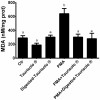Ex Vivo Study on the Antioxidant Activity of a Winemaking By-Product Polyphenolic Extract (Taurisolo®) on Human Neutrophils
- PMID: 34201732
- PMCID: PMC8300751
- DOI: 10.3390/antiox10071009
Ex Vivo Study on the Antioxidant Activity of a Winemaking By-Product Polyphenolic Extract (Taurisolo®) on Human Neutrophils
Abstract
Oxidative stress (OxS) has been linked to several chronic diseases and is recognized to have both major causes and consequences. The use of antioxidant-based nutraceuticals has been licensed as an optimal tool for management of OxS-related diseases. Currently, great interest is focused on the valorization of agri-food by-products as a source of bioactive compounds, including polyphenols. In this sense, we evaluated the efficacy of a novel nutraceutical formulation based on polyphenolic extract from Aglianico cultivar grape pomace (registered as Taurisolo®). In particular, we tested both native and in vitro gastrointestinal digested forms. The two extracts have been used to treat ex vivo neutrophils from subjects with metabolic syndrome, reporting a marked antioxidant activity of Taurisolo®, as shown by its ability to significantly reduce both the levels of reactive oxygen species (ROS) and the activities of catalase and myeloperoxidase in the cell medium after stimulation of neutrophils with phorbol 12-myristate 13-acetate (PMA). Interestingly, we observed an increase in intracellular enzymatic activities in PMA-treated cells, suggesting that Taurisolo® polyphenols might be able to activate nuclear factors, up-regulating the expression of this target antioxidant gene. In addition, Taurisolo® reversed the increase in malondialdehyde induced by PMA; reduced the expression of pro-inflammatory genes such as cyclooxygenase 2 (COX-2), tumor necrosis factor alpha (TNFα) and myeloperoxidase (MPO); and induced the expression of the anti-inflammatory cytokine IL-10. Overall, these results suggest the efficacy of Taurisolo® in contrasting the OxS at blood level, providing evidence for its therapeutic potential in the management of OxS-related pathological conditions in humans.
Keywords: agri-food by-products; blood cells; grape; nutraceutical; oxidative stress; polyphenols.
Conflict of interest statement
The authors declare no conflict of interest.
Figures





Similar articles
-
Grape Polyphenols Ameliorate Muscle Decline Reducing Oxidative Stress and Oxidative Damage in Aged Rats.Nutrients. 2020 Apr 30;12(5):1280. doi: 10.3390/nu12051280. Nutrients. 2020. PMID: 32365992 Free PMC article.
-
Effects of Grape Pomace Polyphenolic Extract (Taurisolo®) in Reducing TMAO Serum Levels in Humans: Preliminary Results from a Randomized, Placebo-Controlled, Cross-Over Study.Nutrients. 2019 Jan 10;11(1):139. doi: 10.3390/nu11010139. Nutrients. 2019. PMID: 30634687 Free PMC article. Clinical Trial.
-
Vascular Effects of the Polyphenolic Nutraceutical Supplement Taurisolo®: Focus on the Protection of the Endothelial Function.Nutrients. 2021 May 2;13(5):1540. doi: 10.3390/nu13051540. Nutrients. 2021. PMID: 34063322 Free PMC article.
-
Nutraceutical polyphenols: New analytical challenges and opportunities.J Pharm Biomed Anal. 2019 Oct 25;175:112774. doi: 10.1016/j.jpba.2019.07.022. Epub 2019 Jul 15. J Pharm Biomed Anal. 2019. PMID: 31336288 Review.
-
Muscle redox disturbances and oxidative stress as pathomechanisms and therapeutic targets in early-onset myopathies.Semin Cell Dev Biol. 2017 Apr;64:213-223. doi: 10.1016/j.semcdb.2016.08.003. Epub 2016 Aug 12. Semin Cell Dev Biol. 2017. PMID: 27531051 Review.
Cited by
-
Mitigating Age-Related Cognitive Decline and Oxidative Status in Rats Treated with Catechin and Polyphenon-60.Nutrients. 2024 Jan 26;16(3):368. doi: 10.3390/nu16030368. Nutrients. 2024. PMID: 38337652 Free PMC article.
-
Valorization of Grape Pomace: A Review of Phenolic Composition, Bioactivity, and Therapeutic Potential.Antioxidants (Basel). 2024 Sep 19;13(9):1131. doi: 10.3390/antiox13091131. Antioxidants (Basel). 2024. PMID: 39334790 Free PMC article. Review.
-
Nutrients and Nutraceuticals from Vitis vinifera L. Pomace: Biological Activities, Valorization, and Potential Applications.Nutrients. 2025 Feb 5;17(3):583. doi: 10.3390/nu17030583. Nutrients. 2025. PMID: 39940441 Free PMC article. Review.
-
Antiherpetic Activity of Taurisolo®, a Grape Pomace Polyphenolic Extract.Microorganisms. 2023 May 20;11(5):1346. doi: 10.3390/microorganisms11051346. Microorganisms. 2023. PMID: 37317320 Free PMC article.
-
A Phase II Study on the Effect of Taurisolo® Administered via AEROsol in Hospitalized Patients with Mild to Moderate COVID-19 Pneumonia: The TAEROVID-19 Study.Cells. 2022 Apr 29;11(9):1499. doi: 10.3390/cells11091499. Cells. 2022. PMID: 35563805 Free PMC article. Clinical Trial.
References
Grants and funding
LinkOut - more resources
Full Text Sources
Other Literature Sources
Research Materials
Miscellaneous

